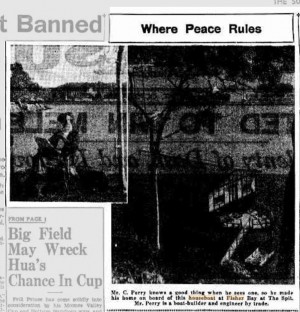| Perry Houseboat Fisher Bay | |
|---|---|
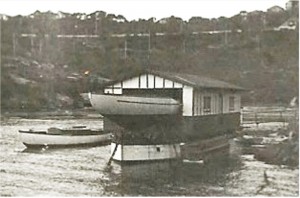 Janaway being launched from Perry Houseboat Fisher Bay   Photo from NR Perry Surfboats of the Perry Houseboat Fisher Bay  Two Houseboats in Fisher Bay  Janaway at Perry Houseboat Fisher Bay just after Launching before being fitted out 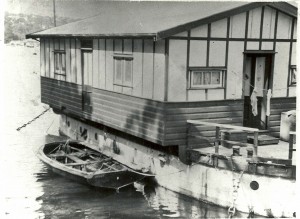 Perry Houseboat Fisher Bay  Perry Houseboat Fisher Bay 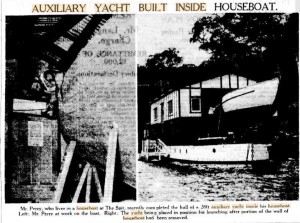 From Trove 9th March 1938 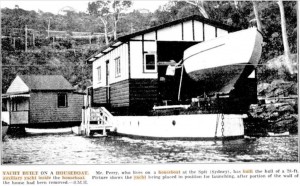 From Trove: Chronicle 24th March 1938. Perry Houseboat Fisher Bay | |
| Country | Australia |
| Boat Type | Houseboat |
| LOA | 17.09m, 56.1f |
| Beam | 6.12m, 20.1f |
| Year Build | 1932 (age 92) |
| Owner (s) | Syd Perry |
| Builder | Syd Perry |
Perry Houseboat Fisher Bay
Also called
Fisher Bay Houseboat 1932 - 1937
Perry's Boatshed 1937 to 1938 to build little Janaway
Perry's Houseboat 1938 to 1952
History | Prepared by David Payne Honorary Research Associate (Curator Historic Vessels 2004-2020 Retired) ANMM SignificanceThe Fisher Bay Houseboat that is located on the water, moored in Middle Harbour NSW, is a vessel that holds the legacy of the Great Depression, a major world-wide event of the 20th century that continues to be relevant in the 21st century as economic fluctuations and Covid pandemic repercussions bring its memory to the fore. The profound impact of the Depression is still felt by families today through the legacy of their forebears who lived through it. This houseboat, from this crucial period, is a rare Australian maritime object that, in its current state, can demonstrate a unique boatbuilding and maritime story of living through the Great Depression. Restored, it can bring that story to life again. HistoricalThe Fisher Bay Houseboat from 1932 is a wooden domestic house structure built atop of the steel hull of a surplus munitions barge, which is now held within a rectangular concrete pontoon hull and floating. It is moored close to the shoreline at Fisher Bay, on Middle Harbour in Sydney, NSW. It is about 19m long by 7m wide. The initial construction of the house onto the barge was in 1932. The houseboat has been located at this original site since 1932, and during the 91 years occupation of the site it has only been moved for maintenance and subsequent repositioning of the steel hull into the concrete supporting hull. The original owner and builder of the Fisher Bay Houseboat in 1932 was Cecil Sydney Perry (Syd), who lived there with his first wife Thelma and his son Cecil Sydney Perry (Jim Perry). During the Depression (1929 to 1939), many victims had lived in tents and humpies on public land. Becoming unemployed, shipwright Syd Perry, Thelma and Jim became homeless. They were left living in a tent at nearby Chinaman's Beach in Mosman, along other homeless people and their tents, including others that were located on Clontarf Reserve opposite on the northern Clontarf and Seaforth shoreline. In this hand to mouth era, the pair made what livelihood they could by rowing across to Clontarf Beach or around to The Spit boatsheds in Mosman to build wooden boats, when work was available. In 1931/32 they built a yacht on the shore at Clontarf. This was the yacht Seabird, and they used the funds from building Seabird to apply for a legal permit to allow them to build a houseboat in Middle Harbour. This was granted to them that year by the then NSW Maritime Services Board. The houseboat hull was purchased as a surplus Australian Government steel-hulled ammunition barge that was associated with the nearby Bantry Bay Explosives Depot. This is a military and civilian munitions store that dates back to 1915 and is now a heritage listed site. The barge was moved and moored in Fisher Bay adjacent to Clontarf where it currently sits, and the Perrys built a traditional, single story, peaked-roof wooden house on top of the barge's deck. This gave them a home and was legally occupied by the Perry family from 1932 and until 1952. It is now one of only two surviving houseboats from this era. The second one, significantly renovated, is sited further up Middle Harbour in Pearl Bay, Mosman. Pursuant to legislation, no houseboat site, or place will ever be granted again by NSW Government within Sydney Harbour NSW. This houseboat was initially known as Fisher Bay Houseboat in 1932, but later was briefly termed Perry's Boatshed, and finally Perry's Houseboat from about 1938 onwards. The primary use for the Fisher Bay Houseboat was private, it was 'domestic residential' and that has been its role throughout. However, there is the intriguing, additional story of the house part being cleverly adapted for a period to build a yacht in the late 1930s and then maintenance and repairs on smaller craft in the early 1940s, leading to the Perrys Boatshed title. Whilst occupied by the Perrys until they left it in 1952, living conditions were very basic, with little or no heating, hygiene, refrigeration, or power. Their capabilities, fuelled by a classic Australian 'can-do' attitude that built the houseboat in the first instance, was further demonstrated through their building of the yacht Janaway inside their home on the barge. The Perry's made a number of local newspapers in 1938, detailing this highly unusual build. She was described as "The epitome of the best designs of her time". Janaway was an early design by Wally Ward, and built afloat by Sid and Jim Perry inside their houseboat. The living room partitions were removed and the space became a shed while the Perry's could live down below in the hull as the building proceeded. From a newspaper clipping (approx. Oct 1938) Titled "Auxiliary Yacht Built inside Houseboat" depicting Mr. Jim Perry at work. "One owner Sid Perry built a 30-foot yacht inside this houseboat and took the inshore wall off to launch it then towed it across to the Griffins boatshed to put the keel on. The houseboat was one of two moored in Sandy Bay on the Clontarf side." In the 1930s Cecil Sidney Perry and first wife Thelma Dorothy Perry recorded their address as "Houseboat Fisher Bay". (Australian Electoral Rolls 1893-1949 "Subdivision of Mosman 1935). Also noted on the electoral roles were Sid's occupation as a 'carpenter', while Thelma had to settle for the standard title of the period, 'home duties'. The Perry's lived on the houseboat for close to 20 years, with basic utilities. Thelma Perry (first wife of Jim Perry) found these living conditions impossible and left her son Errol and Jim. May Perry (second wife of Jim Perry) met her to be husband Jim at the Trocadero which was a large art deco dance hall in Sydney from 1936 to 1971. May married Jim taking on all domestic duties such as meal preparation and hand sewed clothing, cooked and cared for numerous Perry males. May and Jim Perry had first born son Bryan in 1946, and second child Alan in 1948. May Perry fell pregnant with her third child Graeme 'Tom' Perry in 1951. May Perry sewed and hung curtains, to create a proud home. However, the absence of then modern technology became untenable and unbearable for the Perry's. The Perry's were distrusting of banks in the early years, during and after the Great Depression. Enough cash was saved over this period to finally purchase affordable land, at nearby North Balgowlah in the early 1950s. This land was close to Middle Harbour, and referred to by the yachting community as 'Spinnaker Hill'. The Perry's built a shed on the block. Shelter and utilities finally made life easier. The houseboat and its barge then changed hands in 1952. Under later owners, the old steel hull and house was eventually floated into a new rectangular concrete pontoon or barge hull, and this remains in situ. Ownership changed over the years and the wooden structure has been slightly adapted by new owners, but it remained as a private residence, and is not currently occupied. TechnicalThe current length of the vessel is 56.1 foot (18.7m) long by 20.1 foot wide (6.7m) wide. The Australian Government ammunition barge hull which was used prior to 1932 is understood to between 90 to 105 years old, based on the Bantry Bay depot being established in 1915. The steel plated, riveted hull has a round bilge hull section. The barge has been identified as follows: "The description of government lighter barge strongly suggests to me, that it was originally used in connection with the powder hulks at Powder Hulk Bay or after at the 1915 Bantry Bay Magazine. There are records of some downsizing of the Bantry Bay Magazine in the 1930's due to the depression which might account for the lighter being sold off". Mr. Robert Curran, Maritime Museum and UNSW alumni "Yes, we can confirm that it is an ammunition barge that was surplus to requirements and disposed of by the Dept. of Supply." Naval Historical researcher, Mr. Rob Guest, through the assistance of Commodore Brad Smith Royal Australian Navy. The remaining original fabric of the wooden Perry's Boatshed structure is approximately 90 years old. InterpretationThe Fisher Bay Houseboat demonstrates many aspects of the story of the Great Depression era, but is unique in Sydney and perhaps throughout Australia with its maritime connection as a houseboat. The houseboat is a rare object and example of a family's life in the depression years, located on the water, and still occupying its original site or location. The houseboat and barge tell the story of what became an extremely uncommon way of life within the maritime industry. Community associationsThe Fisher Bay Houseboat is directly connected to the Bantry Bay Explosives Depot, a former munitions and explosives depot located at Killarney Heights in Upper Middle Harbour and built in 1915. The hull of the ammunition barge remains as an example of the NSW Heritage listed Bantry Bay Explosives Depot. The Perrys are associated with a number of vessels and other yachting connections. In 1936, Sid and son Jim travelled to Lord Howe Island and built the launch Albatross. Albatross remains on Lord Howe Island, owned by resident Mr. Ed. Rourke and is one of very few vessels built on Lord Howe Island NSW. It is listed on the Australian Register of Historic Vessels, managed by the Australian National Maritime Museum and the Sydney Heritage Fleet. The Perrys have a strong connection to Middle Harbour sailing community. In 1939, Sid and Jim Perry were part of a group of founding members of the Middle Harbour Cruising Yacht Assoc. which is now known as the Middle Harbour Yacht Club. They built the first yacht on the register Flying Cloud MH1 in 1941. Yachts built by Sid and Jim Perry include Moonya, Bimini, Eudoria, Malohi, Nor Wind and Epacris, and most were connected to Middle Harbour owners. Through subsequent generations the Perrys have remained involved in boat building and the marine trade. The 3rd generation of Perrys includes Bryan Perry, a shipwright and boat builder who was established in Southport for many years, His brother Alan was a marine engineer, the other two brothers were shipwrights. 4th generation shipwright Nathan Perry remains working on the Northern Beaches, and continues to build boats some 90 years later. He has made a significant impact in the Surf Life Saving movement as a surf boat manufacturer. The skillset of Shipwright/ boatbuilder has been passed down for a number of generations. Nathans son Alan Perry (Jnr) is currently employed by his father at Brookvale NSW manufacturing and repairing surfboats and oars. Alan (Jnr) intends to enter the industry as a 5th generation boatbuilder. Statement of SignificanceThe Fisher Bay Houseboat is a rare Australian object from the Great Depression period, demonstrating the narrative of this devastating crisis on the working class from a maritime aspect, with unique details. It is a story told by the Perry family, where the first two generations, Sid Perry and his son Jim, pulled themselves up from the bottom with a can-do attitude, creative thinking and plain hard work. Their groundwork set up their next two generations to carry on their trade as shipwrights, which is continued today. This was a pattern for others in that period, always looking for an opportunity and the Fisher Bay Houseboat holds that story, from a boatbuilding and marine aspect and at present can tell it at the site where it happened. It is one of only two houseboats left from that site and period, and the only one that is able to relate such a strong story.
|
Pictures | Fisher Bay Houseboat pictures The ammo barge inside the Fisher Bay Houseboat / Perrys Houseboat was purchased from Bantry Bay (used around WW1 times). Bantry Bay would have been in full 0peration around WW2.
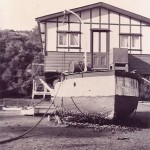 Perry Houseboat Fisher Bay 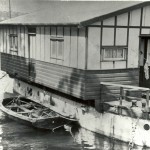 Perry Houseboat Fisher Bay  Sailing pass the Perry Houseboat Fisher Bay 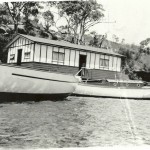 Janaway at Perry Houseboat Fisher Bay just after Launching before being fitted out  Two Houseboats in Fisher Bay 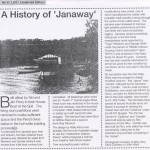 A History of Janaway  Fisher Bay Houseboat in 1935. This pic posted by Heritage NSW on Facebook 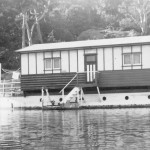 The ammo barge up on the hard. This photo was provided by Grahame "Tom" Perry (Number 4 son) 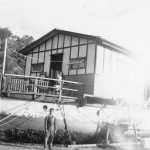 Jim Perry in overalls. May Perry on the deck with either baby Bryan or Alan. This photo was provided by Grahame "Tom" Perry (Number 4 son) |
Memories | Dennis Francis MemoriesFisher Bay HouseboatDuring the Depression there were up to 32 legal residential houseboats moored in Middle Harbour. Today only four remain; this one - which started life as a steel-hulled barge - and three others in Pearl Bay, on the other side of Spit Bridge. In the late 1940s, this houseboat was briefly the childhood home of local resident Dennis Francis who recalls;
Johanna PerryJust another interesting tit bit - none of the Perrys and perhaps some of the other builders down at the Spit and or on the Sydney waterfront were forced to go to WW2 as "Boatbuilding" was a protected industry. David Payne confirms "They weren't the only ones. The Halvorsens stayed working in their yards, Billy Barnett stayed where he was, my uncle stayed at Cockatoo Dockyard in the drafting part, a number of tradesman were kept here to manage others with little or no experience brought in to form a workforce to build various small craft throughout the war. From NR Perrys SurfboatsHere's a bit of an article on my family Heritage. I come from a long line of shipwrights.
One of the house boats is still there.
To give you an idea of the time frame, my memory of my grandfather Jim was a very old man sitting in his TV room when I was a child. I recall he was nearly 80 when I was 10. Sid and Jim (their real names were both Cecil Sydney Perry, but both couldn't be Sid) lived in a tent on Chinaman's beach near Balmoral and rowed to Clontarf each day to build their boats on the beach.
One owner Sid Perry built a 30ft yacht for the Hobart Race inside this houseboat and took the inshore wall off to launch it then towed it across to the then Griffin's boatshed to put the keel on.
The houseboat was one of two moored in Sandy Bay on the Clontarf side.
Bob work on the houseboat slipping and painting. He'd get a rope through the top floor doors either end and tie to a tree and pull it manually inshore like pulling a fishing net and wait for the tide to go out. it weighed about 80 ton.
The Sun 31st October 193731 Oct 1937 - Where Peace Rules - Trove (nla.gov.au)31 Oct 1937 - Where Peace Rules - Trove (nla.gov.au) Mr. C. Perry knows a good thing when he sees one, so he made his home on board of this houseboat at Fisher Bay at The Spit. Mr. Perry is a boat-builder and engineer by trade. |
Boat Association | Built at Fisher Bay HouseboatBoats built by Sid Perry and Jim Perry include:
Other Boats Built by Perry FamilyAlbatross Motor Launch, built by Sid Perry on Lord Howe Island. |



